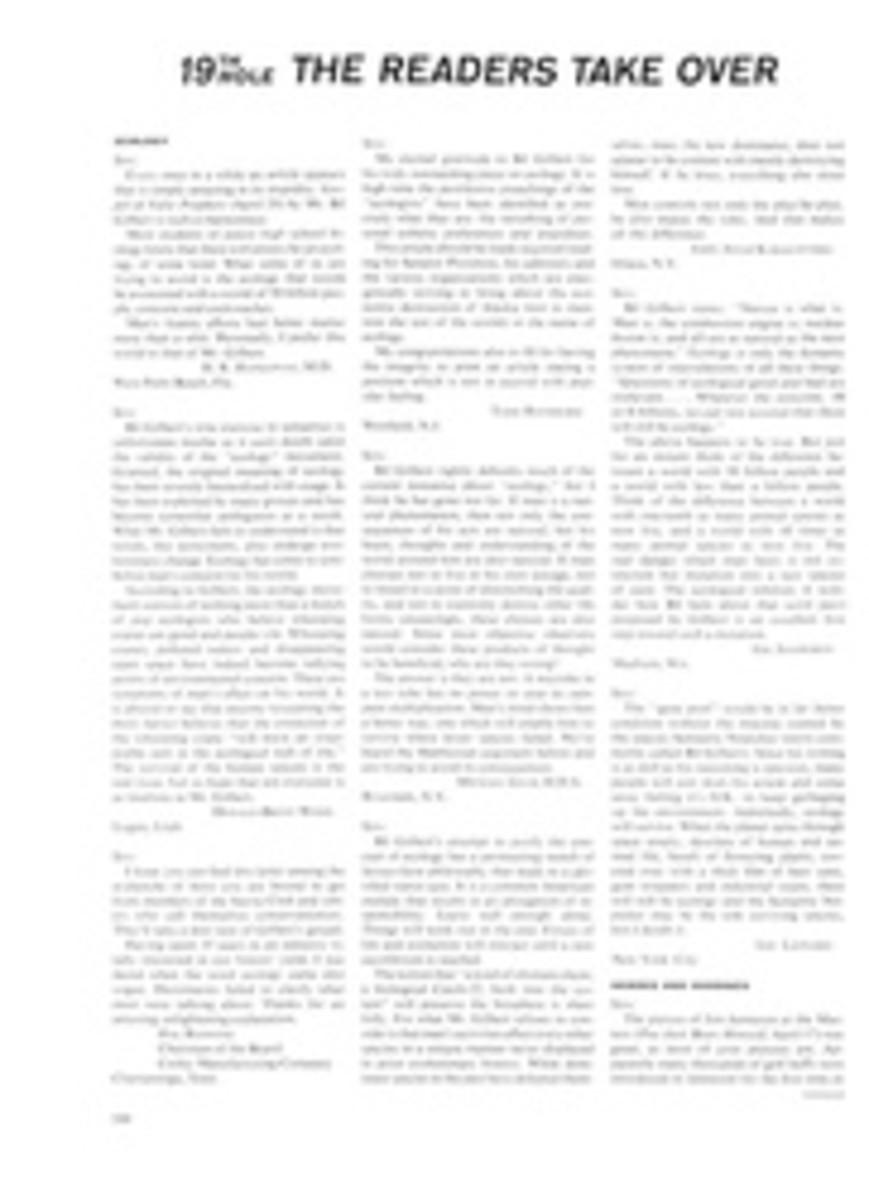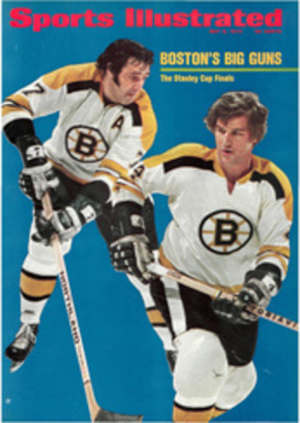
Merely a matter of evolution
This is baseball's spring of streaks. If you don't have one, you're out of it. The Houston Astros win nine games in a row, the Chicago Cubs lose eight. Jim Fairey of the Montreal Expos comes up three times late in games and produces the game-winning hit on each appearance. The Boston Red Sox finish the week with a remarkable record: times at bat, 320; home runs, none. Charlie Finley and Vida Blue hit 0 for 78 in conferences. And, of course, just as all the Minnesota Twin fans in Bigfork and Minnehaha had bragged he would, Bobby Darwin leads the American League in home runs (five) and runs batted in (15), hits safely in all the Twin games (11) and has a .439 batting average.
In most parts of the country people believe that the home-run leader in the American League has to be named Frank Howard, Carl Yastrzemski, Reggie Jackson, Richie-Dick Allen, Boog Powell or Harmon Clayton Killebrew Jr. Suddenly it is Bobby Darwin, a 29-year-old rookie centerfielder, and he is plunging headline writers into deep water: DARWIN GOES APE; DARWIN'S EVOLUTION; DARWIN GIVES HIS THEORIES.
Darwin's fast start put the Twins in first place in the American League West—not bad for the fifth-place finisher last season—but Darwin's is not the only Minnesota evolution. The Twins are baseball's most changed team, having started the season with 12 players who were not with the club on Opening Day last year. And they have gotten going with a rush despite the absence of Tony Oliva, the league's best hitter, who is slowly recovering from a knee injury. The Twins pitch. They run. They catch balls in their gloves for the first time in years. Their bullpen can stop the enemy. And when the Twins are not performing these wonders they watch Bobby Darwin and marvel at what he has at last accomplished.
By the week's end Darwin had played in four stadiums this season and hit a homer in each. In Oakland he reached the seats in the upper deck, some 460 feet from the plate, and at Yankee Stadium he launched one of Mel Stottlemyre's breaking pitches 450 feet to win the game. "It's an amazing thing," says Bob Rodgers, Minnesota's bullpen coach, "but every time he comes up, all action in the pen ceases. They want to watch Bobby hit."
Darwin's home runs look like Killebrew's. When Harmon homers, the ball tends to rise high and hang in the air for a long period of time before falling on someone's head in the bleachers. When Harmon hits a good one—"gets it all," as the players say—he comes out of the batter's box slowly and turns his head to the left to watch it go. He seems to take a quiet joy in his homers, as he should. Of the 515 he hit prior to the start of this season, 103 were game winners. Some were only 340 feet, but others went $18 on the meter.
Before Darwin, however, Killebrew's summers were often measured out in bases on balls. Over the last three seasons he drove home 372 runs and was walked 387 times. Pitchers worked around him rather than let him tear a game apart. Although he is no speedball, in his good seasons he will score 100 runs if the man hitting behind him is effective.
So far Darwin has been very effective, a fact all the more curious because he has made the rare transition from pitcher to hitter. Most switches in major league baseball are from hitter to pitcher. The vice versas are few but sometimes interesting: the Babe Ruths, Stan Musials, Johnny Lindells.
The Los Angeles Angels signed Darwin to a $40,000 bonus as a pitcher back in 1962 and thought enough of his 11-6 record at San Jose to bring him to the majors at the age of 19. He pitched three innings, suffered a loss and had an earned run average of 12.00. This revealing experience was followed by a short stay in Hawaii, and then down, down, down to Stockton, Calif. and Elmira, N.Y. By 1970 Darwin's minor league pitching record was 42-50, and his batting average was .231. Some now say that they knew all the time Darwin would make a fine home-run hitter because he had such a powerful batting stroke. But during eight seasons in the minors it produced exactly six homers and 28 RBIs.
In the spring of 1970 Darwin, by then the property of the Los Angeles Dodgers, decided to try to make it as a hitter. Los Angeles farmed him out to Bakersfield of the California League, one of the bottom rungs on the minor league ladder. Despite striking out 127 times in 303 times at bat, he hit 23 homers and averaged .297. That winter he played at Hermosillo, Mexico where his manager was Maury Wills, a man who had spent nine years in the minors himself before getting to the big leagues. Wills encouraged Darwin. He told him that he had to learn more about the strike zone and be more selective about which pitches could be hit for homers, which for singles. ""I knew that Bobby had the dedication." Maury says, "but when you play winter ball you tend to think at times that nobody is watching you and nobody really cares what you are doing. It is very easy to get down on yourself. Bobby didn't do that."
Darwin returned to the Mexican Pacific Coast League last winter and led in homers with 27, and balls were flying off his bat like jumping beans. The transition was now starting to interest people, the lights in the Mexican league being such that if the bulb burns out the game is off. Bobby's good performances at Hermosillo and at Bakersfield resulted in his elevation to the 40-man Los Angeles spring roster. He went to Vero Beach and led the team with a .488 exhibition-game batting average. At the time Los Angeles had a complete stock of outfielders: Willie Davis, Willie Crawford, Manny Mota, Richie Allen, Bill Buckner, Von Joshua, Bill Russell. There was no room for Bobby Darwin, and he was dispatched to Spokane, where he reduced his strikeouts from about one in every two at bats to one in four. He hit 17 homers and had a .293 average. The Dodgers brought him up toward the end of the season, and he got five major league hits in 20 at bats. One was a homer. Then, in October, Minnesota traded for him.
The Twins slapped uniform No. 53 on Darwin's back, and the kids around Tinker Field in Orlando, Fla., where the team trained, would holler, "Hey, 53, how about signing an autograph?" Last week, whenever he came out of the dugout, now wearing No. 2, the autograph seekers would plead, "Oh, Mr. Darwin, please." From "Hey, 53" to "Mr. Darwin, please," is how you measure fame.
The hardest thing for Darwin to do these days is go through the same interview over and over again. How did you change? Why did you change? Are you real? You know this game is not supposed to be this easy? Darwin answers the questions, smiles and rubs the barrels of new bats with a bone to harden them, something last seen in a major league clubhouse in Ty Cobb's era. Following three waves of interviewers last Friday night in the visitors' clubhouse at Yankee Stadium, he seemed startled at the attention he was drawing. What, he was asked, did he enjoy most about all this? He said, "Maybe the thing I like the best is seeing the ball go over some outfielder's head and into the stands. I enjoy seeing the pitcher drop his head in disgust. Remember, it used to be my head dropping, my pitches being hit out of ball parks."
PHOTO
BOBBY SLAMS A STOTTLEMYRE PITCH FOR GAME-WINNING HOMER AGAINST NEW YORK

